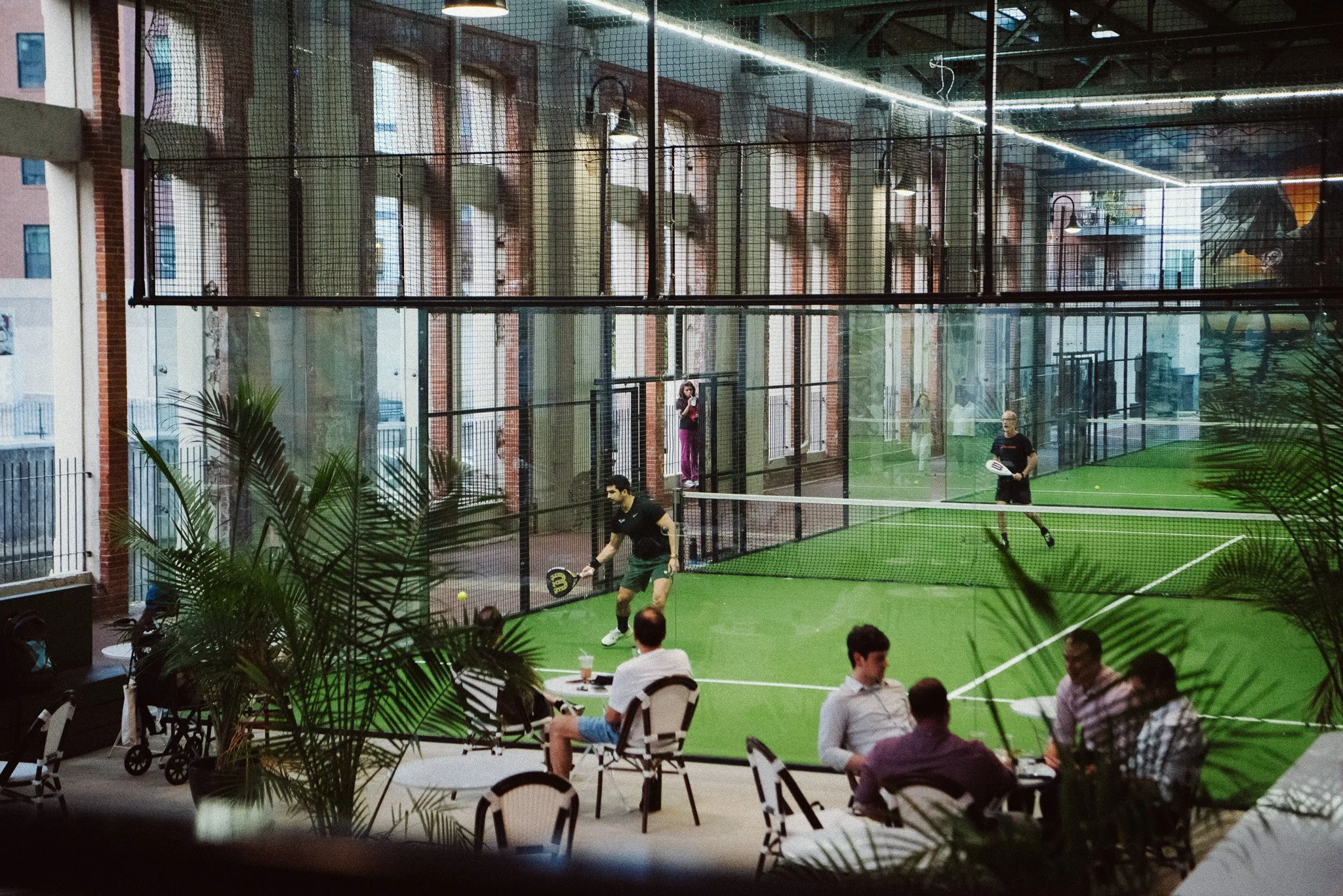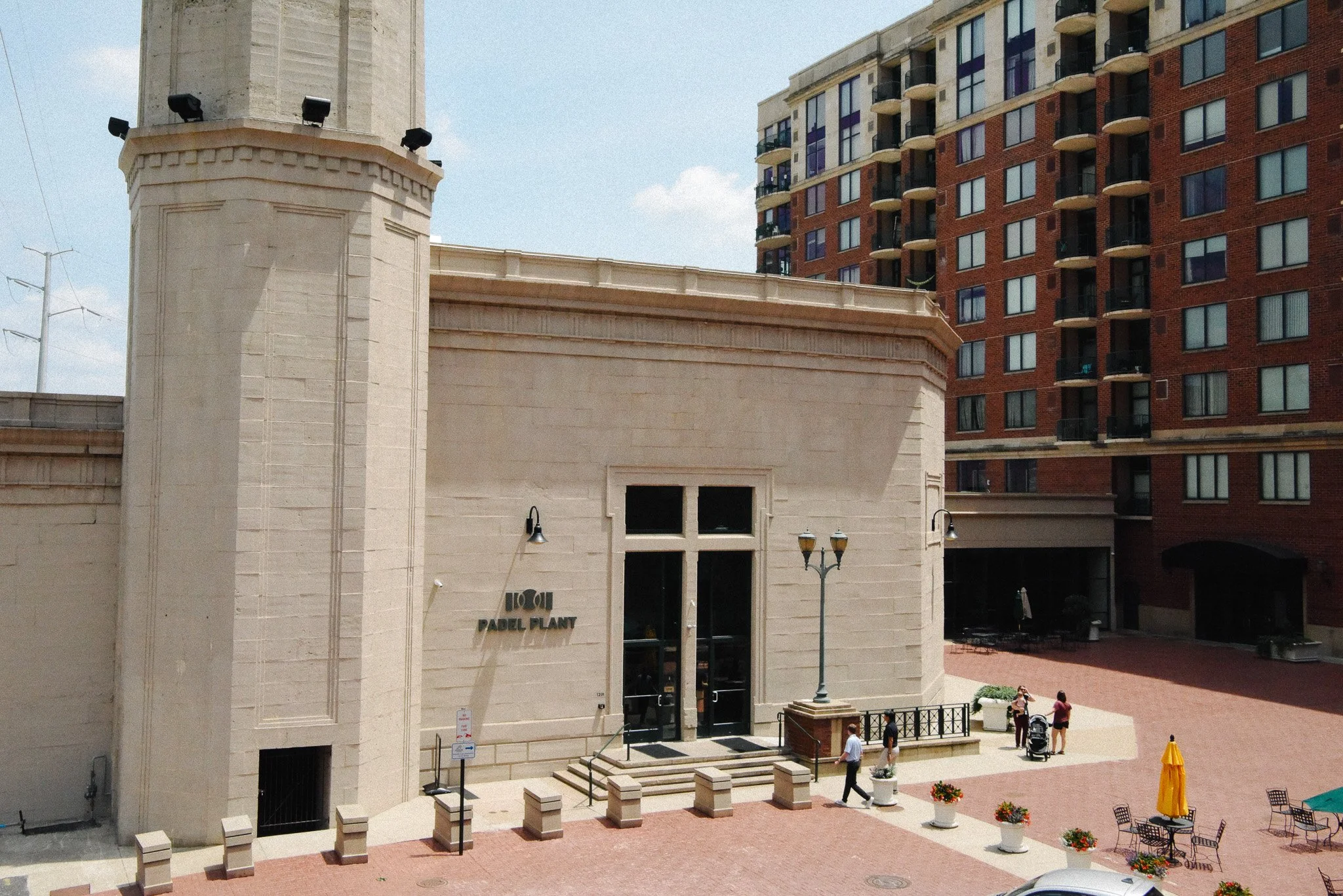
Padel entrepreneurs get creative to solve tricky real estate problems.
WORDS
Emily Nutbean
PHOTOGRAPHY
Jewel Nguyen, Javier Romero & Greg Surine
It should come as no surprise to readers of this magazine, but padel is taking the world by storm.
Across the globe, keen racquet sport players have been drawn in by its fast pace, addictive format and accessible nature. In America, as the sport is beginning to make waves, court builders are eager to satisfy growing demand by building as much as they can across the country.
However, a common issue continues to arise. Padel courts are complicated to construct: the high ceilings, necessary column spacing and glass panelling are all unique obstacles that pickle and tennis courts do not have to navigate. All of which makes building a padel court from scratch, especially an indoor facility, incredibly costly.
To solve these logistical problems, passionate entrepreneurs are resourcefully repurposing existing structures. From power plants to hockey rinks to shopping malls, padel courts are popping up in the most unexpected places.
These repurposed spaces can seemingly solve the challenge of finding great indoor real estate, with high enough ceilings to accommodate the courts. For indoor structures especially, an unused building can be the answer to an entrepreneur’s quandary.
Photo by Jewel Nguyen
One such example can be found in Richmond, Virginia, where an old hydroelectric power plant has been rebuilt as a padel facility. Built in 1898, the plant sits between the Haxall Canal and the James River, part of Richmond’s scenic Canal Walk. Once abandoned, it’s now home to Padel Plant, a lively community hub run by brothers Sam and Alex Nordheimer, and their cousin Kyle.
The idea was sparked in 2021, when Sam and Alex discovered padel while on vacation in the Bahamas. They played daily, hired a coach to teach them the rules and were desperate to find out where they could play back home.
However, back in 2021, the US was embracing pickleball nationwide, and there were only around 200 padel courts across the country. Disheartened by the lack of courts, the brothers began to consider how they could bring padel to their home in Bethesda, Maryland.
“There was this huge gap between what the United States was doing and what seemed like everybody else was doing,” Sam remarked. “So that was when the idea really first came to us, but we were actually still in college at the time, so I sort of forgot about it and went back to school.”
A second trip rekindled the dream. Joined by their cousin Kyle, the brothers began searching for potential spaces in Bethesda, soon expanding to Baltimore and finally settling on Richmond, where Alex spotted the old hydroelectric plant.
Photo by Jewel Nguyen
Its striking industrial architecture had instant appeal. “We thought it was one of the most unique buildings we'd ever seen, not to mention a fantastic sort of structure for what we were going for, which was a racket sports facility, but also one where we could build community by having a really strong restaurant or food and beverage program,” said Sam.
They bought the building in January 2024, started construction in July, and opened six months later, alongside their own pizzeria, Smokestack Pizza and Bar. Currently the only padel club in Richmond, it’s used by expats, students, retirees, office workers — essentially anybody who is drawn in by the laughter that inevitably accompanies the game.
However, creating this social and inviting space, although speedier than building from scratch, was far more complicated than one would expect. Transforming the plant into a padel hub required vision, patience, and a lot of paperwork.
Sam explained: “There's quite a lot of money that had to go into improving it, and there's a lot of regulatory things you have to deal with when working with older buildings. With a historic building like this, lots of different design choices have to be approved. So there are some downsides.”
Despite the challenges, Sam thinks that pop-up-style padel venues can be a great solution for those struggling to find suitable real estate, while also serving as a great way to turn abandoned buildings into recreational spaces.
He said: “If you're able to turn something which really had no purpose or little purpose, into something that's a great community asset, I think it's a wonderful thing to do, and something that lots of people should consider when they look to build their own padel clubs or other facilities.”
Photo by Jewel Nguyen
While Sam, Alex and Kyle discovered padel on holiday, Eric Loftus, a partner at Northeast Padel, has been aware of the sport for much longer. He built one of America’s first padel courts three decades ago. When he noticed the sport’s growing popularity in 2021 at FSB, an international sports show held in Germany, he knew he needed to seize the opportunity.
With decades of experience in racquet sports, Eric co-founded Northeast Padel in 2022 and began installing courts across the country. His company focuses on building to professional standards, ensuring every court meets the American Sports Builders Association’s specifications.
Working across the Northeast means extreme weather is an unavoidable factor. Most of their courts are outdoors, so the structures must withstand high winds, storms and heavy snow. The engineering challenge doesn’t faze Eric. He told me, “We can confidently sell somebody a padel court that we can take to the local building authority, and get it approved. And we've now had American engineers stamping and approving them. So we're building something for the long run in the American market.”
Similar to the Nordheimers, Eric has struggled to find real estate that can support the high ceilings and column spacing required for padel. Many clients are private homeowners wanting tennis courts to be converted to padel in their back gardens, which brings its own challenges.
“There are some challenges there as far as construction and cutting into the old court and pouring a concrete beam and that sort of thing,” he says. “And there's been big back gardens where I've had to pull everything on the crane over walls and drop them into a little hole. But there's always a way, if you're creative.”
Local resistance has been another obstacle. In a country dominated by pickleball, many local governments have never heard of padel. “I think they’ve been kind of resistant, depending on where they are, but if you follow the compliance of rules around other structures and everything else, they get done,” Eric commented. “You need to be persistent.”
Northeast Padel has also dabbled in repurposing existing spaces, although theirs is a wholly unique structure. Built in Westerly, Rhode Island, the company constructed a padel court on top of an existing hockey rink. The court will operate seasonally, with the rink returning during the winter. A creative solution to utilising existing space, it shows how adaptable padel can be.
Eric says: “We're looking to build this thing right for the long haul. We're building a strong, durable company. I'm looking forward to the company growing being able to be the top company in the country that really can handle the customer service aspect, the after sales service aspect, the infrastructure, the project management.”
Westerly Public Courts. Photo by Greg Surine.
If constructing a padel court can be tricky, the space around the court can be just as challenging. That was the case for Bruce Townsend, founder of Padel America. Another padel lover turned entrepreneur, Bruce’s enthusiasm for the sport led him to team up with Pickleball America to build a court in the middle of a shopping mall.
Bruce said: “This is literally a huge mall, and in the center atrium, like, right where Santa goes, you know, you have a padel court.
“So it's kind of — it's outside the box. It's disruptive.”
Like many padel players, Bruce fell in love with the game instantly. “All it took was my first time playing padel and five minutes in, something clicked in my brain that this is the greatest sport I've ever played,” he said. “I didn't even need to ever play again, and I decided right then, after the first time playing, to become an entrepreneur and make a living out of opening padel clubs.”
After a few false starts with potential partners, Bruce found Pickleball America, or rather, they found him. Based in Stamford Town Center mall, the company invited him to build a padel court in one of their retail spaces above the pickleball courts. The ceiling proved too low, but the centre atrium was the perfect size.
Or so it seemed. Whilst negotiating with Stamford’s government, which required noise, glass shattering and turf safety reports, Bruce discovered that American fire code required 10 feet of egress around the court, double Connecticut’s local rule.
This setback did not deter him. “I didn't even listen to them, 'cause I'm already visualising — the court's already there in my mind,” he said. “I just hung up the phone. I drove to the mall, and sat in this middle area, just looking around.”
Eventually, Bruce realised he could move back four of the closest storefronts to create the necessary space, a costly fix, but worth it. The result is a striking centrepiece that draws in shoppers.
“People just sit at these tables, they start watching,” Bruce said. “Just the other night I was playing and there were like 15, 16 people up on the mezzanine that were watching for like 45 minutes.”
Bruce’s previous attempts have left him even hungrier to build more courts, as are most of the entrepreneurs who build padel spaces because of their love of the game. He is ready to expand his business, even if the logistics can be a headache.
His determination hasn’t waned. “I’ve been doing it with all my skin behind it,” he said. “It's all my capital. I put all my skin and then I put my blood, sweat and tears behind this big time. I was there for the whole construction process, working side by side with demo crews, the install team.”
Photos by Javier Romero
If America follows the rest of the world with padel, it will soon be unstoppable. Repurposing buildings is the creative way to build padel courts in cities with less suitable real estate, and their unique aesthetics provide players with a memorable and intriguing experience.
As more and more people become aware of padel, it seems likely that entrepreneurs will be able to build courts with little to no pushback from local governments. Although more courts will most likely be built from scratch to satisfy demand, for anyone who needs to get creative, these pop-up projects are the perfect outlet. ✷
ABOUT THE AUTHOR
Emily Nutbean
Emily is a UK-based journalist. A tennis player since childhood, she discovered padel in 2021. She writes primarily about padel to promote it as a sport and show support for local players. She is excited to see the momentum it has gained in the UK and hope America follows suit









